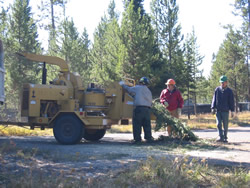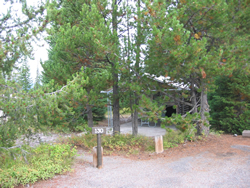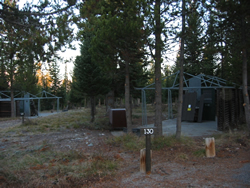
National Fire Plan Success Story
Fuels Reduction Project Protects Rustic Tent Cabins and Guests
Grand Teton National Park, Wyoming
National Fire Plan - Fuels Reduction
2008

Two Grand Teton Lodge Company employees bring limbs to a Teton Interagency firefighter, who runs them through the chipper.

Tent cabin #130 was barely visible through the dense forest surrounding it before employees completed a fuels reduction project around the Colter Bay tent cabins.

Firefighters limbed and thinned trees around tent cabin #130, bringing it up to Firewise standards.
When guests rent tent cabins at Colter Bay in Grand Teton National Park in summer 2009, they will get the rustic experience without the added risk of wildfire, thanks to efforts from interagency fire crews and the Grand Teton Lodge Company.
The tent cabins were tucked away in a dense stand of lodgepole and Douglas fir trees, which provided visual screening, but left them at high risk for a wildfire. In September 2008, saw crews thinned live jackpots of fuels and limbed trees to reduce ladder fuel. The crews left groups of trees in areas surrounded by roads or free of ladder fuels.
The Bridger-Teton National Forest and Yellowstone National Park provided chippers, which were used on most of the resulting biomass. The Lodge Company used the chips in campgrounds, around buildings and on social trails.
“This was a great partnership between our interagency fire crews and the concessionaire to mitigate fuels in a high-risk area,” said Deb Flowers, prescribed fire technician and project lead. “The Lodge Company was able to put the chips to good use, which left fewer piles to burn in the future.”
Some of the boles were cut into firewood that will be used in Colter Bay. Firefighters will burn the few piles created during the project in fall 2009. The remaining dead and downed fuel will be retained on the site as a wildlife habitat component, but has been limbed to reduce fuel bed depth.
Contact: Deb Flowers, Prescribed Fire Technician, (307) 739-3319.